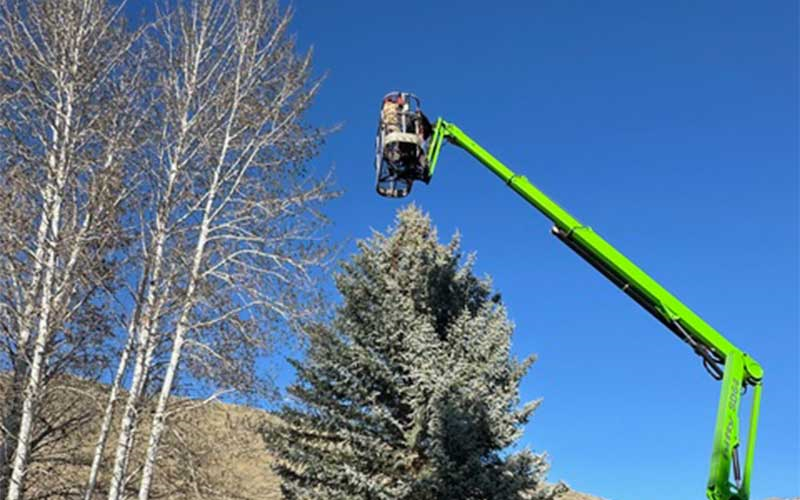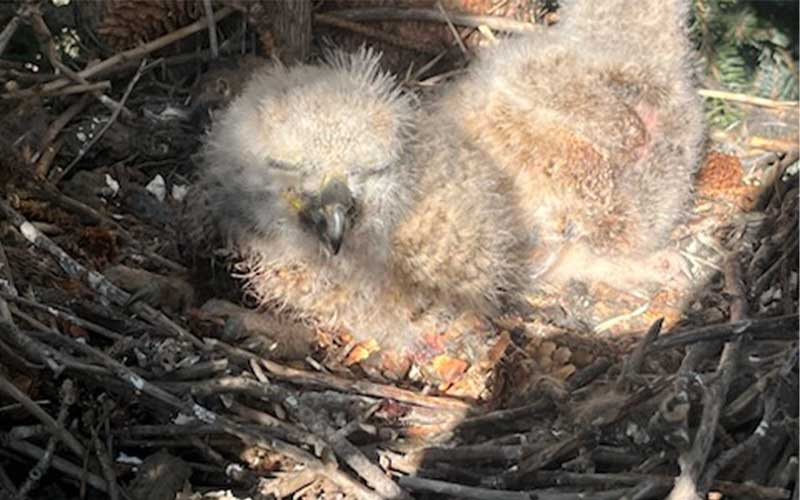|
STORY BY KAREN BOSSICK PHOTOS BY LILI SIMPSON and ROB BECK A baby great horned owl is back in its nest, thanks to a few Wood River Valley residents who flexed their own wings to return the owl to safety. When Lili Simpson spotted the little ball of fuzz on the ground outside her home in Hailey, she thought it was one of her dogs’ stuffed animals.
|
|

Rob Beck and the baby owl went flying without the use of wings.
|
|
|
“Come get Fuzzy Duck,” she called to one of her dogs. Suddenly, she realized it was not Fuzzy Duck at all but a tiny, fuzzy great horned owl. She called the dogs off just in time, put her dogs inside and called a neighbor who had rehabilitated raptors to examine the tiny owl. “It was just the cutest thing…maybe five inches. You could hold it in one hand and cover it with the other. We estimated it was a week to 10 days old, with the most beautiful down feathering.” The baby had apparently fallen out of the nest perched 35 feet high in a Blue Spruce tree during high winds that swept through the valley last week, she theorized.
|
|

Now that all’s well, it’s time for a snooze.
|
|
|
“We were worried because we hadn’t seen or heard the adult owls the night before,” she said. “We weren’t sure they were still at the nest.” After talking with local bird professionals, Simpson and her friend took the owl to a raptor specialist in Bellevue. The specialist assessed the baby and gave him fluids and other care. “I was going to give it some ground turkey but I was told that you need to include bones and stuff—all the things you’d find in a mouse or vole. My friend who rehabilitates raptors said she has to feed the raptors every two hours, that you can’t believe how much they eat.” All the avian specialists agreed that the owl’s best chance of survival since it was so young was to return it to the nest.
Simpson took the owl back to her home, mulling over how best to do that. Happily, she remembered that Rob Beck had just done some work to a neighbor’s tree using a lift. He answered her call while 60 feet up on his lift working on a tree. And Simpson didn’t have to do any wrangling to get him to bring his lift to her yard. “We showed him the nest and up he went, moving sideways to see the nest,” said Simpson. One of the baby’s parents flew off to a nearby tree, which allowed Beck to take pictures of the nest and the other nestling. He then retreated to the ground to retrieve the baby, which was resting comfortably in a box.
With a flick of a switch, Beck did the flying for the bird, which was as yet unable to fly on its own. Together, Beck and the baby owl climbed way back up into the sky via the lift. Beck placed the fallen bird in the nest, took a few pictures to assure the worried onlookers surrounding the tree that it was okay, then returned to the ground. “All in 15 minutes!” said Simpson. “Rob was so helpful and kind and sympathetic! Five days later, both owl parents are around the nest regularly bringing voles and mice to feed the young.” Great horned owls, or hoot owls, are believed to be the most common owl in North America. They lay eggs weeks, even months, before other raptors, which is why Simpson and her friends came across this nesting bird even as the snow was melting in the Wood River Valley.
“Rob said they use other birds’ nests—this one was like a big bowl or dinner plate,” Simpson said. The owls sport feather tufts that resemble catlike ears on their heads and they weigh between two and 5.5 pounds as adults. Adult great-horned owls stand 1.5 to 2 feet tall with a wingspan that can stretch 4.5 feet. They live between five and 15 years in the wild.
|